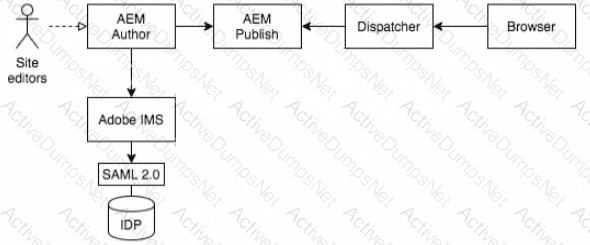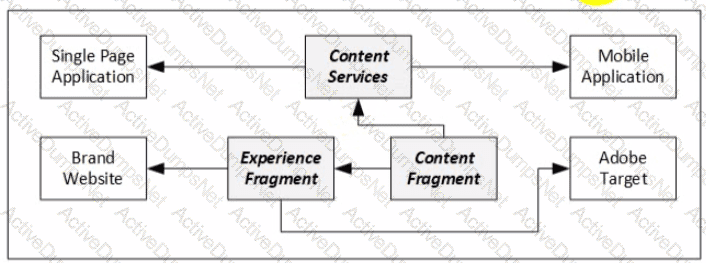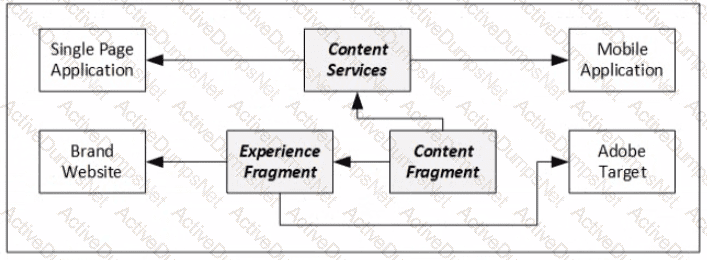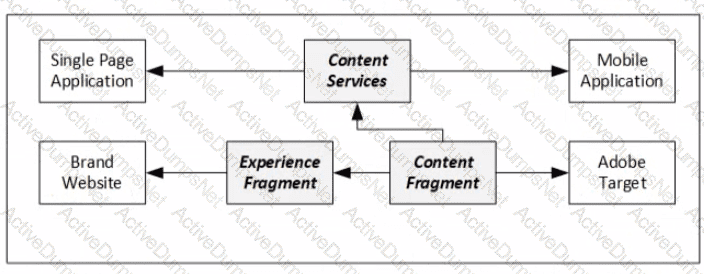Adobe AD0-E117 Adobe Experience Manager Architect Master Exam Practice Test
Adobe Experience Manager Architect Master Questions and Answers
A fashion retail company is planning to enhance the online shopping experience by integrating Adobe Experience Manager (AEM) with a third-party commerce platform using the Commerce Integration Framework (CIF). What are the purpose and benefits of using CIF in this integration?
A website hosted in AEM 6.5 is re-structured with new information architecture for site hierarchy including a new content root. The go-live release is planned to be divided into a few phases on a country basis. Those countries not involved will continue to be served with the existing content resources.
Which configuration would be implemented for the website to continue serving without impacting existing website journeys?
A client is migrating the content from a legacy website to an existing AEM implementation. An Architect evaluates the content of the legacy site and determine-that there are approximately 20.000 pages with a common structure, and a few hundred pages that do not follow a pattern. The client wants to complete the migration as soon as possible.
Which approach should the Architect recommend for the content migration?
A website hosted on AEM as a Cloud Service (AEMaaCS) uses a private key to decrypt data received from a secure web platform. The private key is stored as an encrypted OSGi configuration on the AEM publishers using the OOTB AEM Crypto Support bundle. The architect has received reports from developers stating that while the feature works on the AEMaaCS environments, they fail to decrypt the data on the local development environment.
What two actions would the architect take to resolve the issue? (Choose two.)
A client with an existing AEM 6.5 AMS (Adobe Managed Services) implementation wants to start selling its products in Mainland China.
The client owns a state-issued ICP (Internet Content Provider) license.
The client does not accept high-latency calls for uncached content.
The client does not accept content being potentially blocked by a Chinese firewall.
The client wants to have an in-China hosting solution.
What option would the AEM architect recommend to cover the scenario above?
A user is part of the Employees LDAP group synchronized with AEM. The same user is added to the authors group in AEM. The user is then removed from the Employees group on the LDAP server.
What is the result during the next synchronization with AEM?
A customer wants to implement an AEM solution to serve localized content to several regional websites. Which AEM capability should the Architect recommend?
While developing a public website using AEMaaCS, a client introduces a new requirement on the ability for users to leave comments on the site's pages. How would the Solution Architect respond to ensure the design remains flexible and prepared for potential future modifications while adhering to GDPR regulations?
On AEM 6.5, a new "update asset title workflow" is flooding the JCR with unnecessary information on each instance of the Workflow. In which two ways would an architect prevent the "update asset title workflow" instances from being recorded? (Choose two.)
A client publishes content by a tree activation, which frequently invalidates the page cache in short succession. This causes the visitors to almost always hit an empty cache. The implementation uses a .stat file for invalidation. The client wants to delay the invalidation of cached pages while the publishing is in progress, so that the cached files are served until the invalidation completes. Which AEM dispatcher's feature can the architect propose to delay cache invalidation?
A client wants to change how they publish their content. Refer to the following client business requirements:
• The client has a seasonal business that has significant content changes across their site that need to be rolled out at once based on the season change over date.
• The content authors need to be able to work one season in advance of publish dates to ensure that all changes can be completed on time.
• The content authors need a way to indicate that all the seasonal changes are ready. If the content changes are not completed, then the pages should not get published.
• The content authors need the ability to modify the current live pages without rolling back changes for a future content rollout.
What approach should the Architect recommend?
An AEM architect working on a large-scale e-commerce project is tasked with creating a prototype solution to showcase a proof of concept (POC) using Adobe Experience Manager (AEM) to manage complex product data. Which method or approach would be most effective in ensuring the success of this POC, while maintaining the client project data structure?
A client is in the discovery process for building a React native app, which is a single codebase that runs natively on iOS and Android. The goal is to reduce development costs. The client wants to reduce content creation costs in the new react Native app by reusing as much of the marketing content already publish in their AEM instance.
What should the Architect recommend to meet this requirement?
Refer to the exhibit.

A customer has SSO on its AEM Author environment using Adobe IMS, which is integrated with the customer's IDP using SAML The customer plans to roll out a new secured website on AEM where SSO authentication is required for end users. The end user accounts are also managed in the customer's existing IDP.
How should the Architect set up the authentication for the website?
Content editors are uploading and editing thousands of PDFs daily, and notice a slow down of the AEM system over time while searching for assets in the DAM. The PDFs content does not need to be searchable. What would the AEM architect do to improve performance?
A media company wants to use AEM as content hub for multiple customer touch points:
• Brand-specific marketing websites hosted on AEM Sites
• Single Page Applications using headless content
• Native mobile applications
• Content offers in Adobe Target
The company wants to manage its content efficiently with its small editor staff. Text should be entered and reviewed only once, then reused for all touch points.
How should an Architect incorporate these requirements into a solution that leverages AEM Sites features?
A)

B)

C)

D)

An AEM Sites implementation is migrating from on-premise to AEM as a Cloud Service. Previously, the application was deployed in a single package for both code and access policy nodes. After initial deployment and testing in the new infrastructure, it is reported that user permissions are not working as expected.
What change should the Architect make to address this issue?
An AEM customer is designing a new website. The design shows that images are very prominent on the website but there is a concern about the big variety of aspect ratios used. Images can potentially be used on different places and components on the website. The customer is looking for a maintainable solution to limit the amount of content editing work when adding the assets to the pages.
Which solution should an Architect recommend?
An AEM architect is planning to move the existing content from an AEM 6.5 instance to an AEM as a Cloud Service instance using the Content Transfer Tool. The architect is going to run the offline compaction on AEM 6.5 for migration purposes. What two actions would the architect take before starting the migration? (Choose two.)
A client has an existing AEM site using components that proxy AEM WCM Core Components. The site uses simple page authoring without referenced content, The client wants to create a new experience on another marketing channel. The plan is to use as much of the existing page content as possible to avoid refactoring the current content and to maintain consistency across channels.
Which AEM capability should an Architect use to meet these requirements?
Users report cases where data inaccuracies are present in an AEM component that relies on AEM Search functionality. The AEM platform utilizes Lucene as its main search engine.
How should an Architect resolve this issue?
A client is currently using Assets on AEM as a Cloud Service (AEMaaCS). They are also using BrandPortal to share assets with external vendors. A new vendor was added to the Adobe Identity Management System (IMS) and was assigned the BrandPortal Profile. The client created a Contribution Folder in Assets but was unable to find the new user that was added in IMS to give them permission to the folder.
Why is the user not listed in the list of users to share the folder with?
A client is using AEM and wants to make sure they are managing their configurations correctly. Refer to the following requirements:
The client has multiple brands that they will be hosting on a single AEM implementation
The client wants to reuse as much between brands as possible
Each brand needs to be able to override the default values for items like contact us information
The client plans to support multiple languages in multiple regions for each brand
Each brand/language/region combination will have its own set of content approvers used as part of a custom workflow
Which approach should an Architect recommend to manage the client's configurations for AEM?
A news agency editor wants to publish news articles to an intermediate Publish (preview) instance for internal review before publishing the article to production Publish instance.
Which two steps should the Architect recommend? (Choose two.)
A customer's DAM and Sites is growing exponentially while preparing for a go-live. The AEM architect has noticed that the online compaction on the author failed yesterday and finds this log entry:
INFO [pool-23-thread-1] com.adobe.granite.maintenance.impl.MaintenanceJobsManagerImpl
Name='RevisionCleanupTask', Status='ERROR',
Result='Revision GC: Stopped by user.',
Details='("created":1668218400006,"started":1668218400006,"finished":1668229200598,"duration":10800592}'
What step would the architect take to resolve this issue for the production environment with no downtime?
A customer has a requirement to allow authors to access AEM with single sign-on. To achieve this an Architect needs to integrate AEM with the customer's identity management system.
Which two actions could an Architect take to meet this requirement? (Choose two.)
